
 |
Search | FAQ | US Titles | UK Titles | Memories | VaporWare | Digest | |||||||
| GuestBook | Classified | Chat | Products | Featured | Technical | Museum | ||||||||
| Downloads | Production | Fanfares | Music | Misc | Related | Contact | ||||||||
| SKT425 and the RCA Dimensia Home Entertainment System | ||||||||||||||
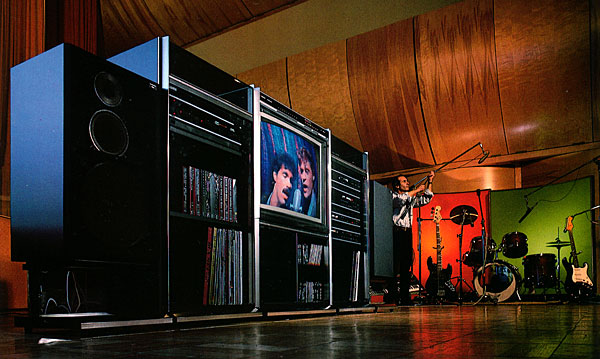
When RCA introduced the SJT400 CED player in 1983, purchasers and members of the technology press noticed that it had a mysterious connector on the back simply labeled "CONTROL" with the owner's manual providing no explanation for its use beyond the statement "Permits connection with accessory equipment that may become available in the future." This fueled speculation concerning what this future use might be, with the most common guess being it was for connection to a personal computer RCA had under development. This had some merit, as other traditional home entertainment manufacturers like Magnavox and Mattel had personal computers on the market of the type that attach to an ordinary television.
This guess turned out to be partially right, as RCA did have a computer under development, but instead of being a general purpose machine attached to a TV, the television itself was the computer. This remarkable new television came in the FKC2600 ebony-finish model and FKC2601 oak-finish model, and was the first TV containing microprocessors capable of external input/output functions. This monitor/receiver was the centerpiece of RCA's new Dimensia home entertainment system, where the TV and all the attached components could communicate with one another in an "intelligent" fashion. The peripheral components included an amplifier, VCR, AM/FM tuner, audio cassette recorder, phonograph, CD player, graphic equalizer, as well as a 400-series CED player. RCA redesigned the SKT400 into the electrically nearly identical SKT425 player to cosmetically conform to the Dimensia styling, but manufacture of CED players ended just before the Dimensia system hit the market. So in an ironic twist, the first true Dimensia component ever released also became the one component never marketed for the system.
 RCA removed most references to VideoDisc in the literature that came with the Dimensia system, and the company renamed the DISC button on the remote VID2. But they missed this in the owner's manuals that came with the amplifier, tuner, cassette player, and turntable, all of which retain the DISC labeling. RCA was very reluctant to talk about using 400-series CED players with Dimensia, but when pressed, engineers would admit the CONTROL jack on the players is a fully-compatible Dimensia SystemLink Interconnection. There simply was no way to remove this functionality without substantially redesigning the Dimensia system. The picture to the left shows how the system works when an SJT400 or SKT400 player is added in. Merely turning on the CED player also automatically turns on the monitor and amplifier, and switches their inputs to that of the CED video and L/R audio. The infrared sensor on the player becomes inactive, as all Dimensia components are controlled by the IR sensor on the TV itself. Another notable change is that the on-screen display (OSD) generated by the player is positioned at the top of the Dimensia monitor rather than at the bottom. This is because the Dimensia system generates its own OSD. This can be up to six color-coded lines added from the bottom to the top of the TV screen, so putting the CED display at the top eliminates the problem of overlap with the bottom line. In this picture, the CED player is in Page Mode with the white text at the top coming from the player and the yellow text at the bottom coming from the vocabulary stored within the computer inside the TV. Page Mode has no use with any other Dimensia component, so the existence of this programming inside the TV proves that RCA designed the system with 400-series CED players in mind.
RCA removed most references to VideoDisc in the literature that came with the Dimensia system, and the company renamed the DISC button on the remote VID2. But they missed this in the owner's manuals that came with the amplifier, tuner, cassette player, and turntable, all of which retain the DISC labeling. RCA was very reluctant to talk about using 400-series CED players with Dimensia, but when pressed, engineers would admit the CONTROL jack on the players is a fully-compatible Dimensia SystemLink Interconnection. There simply was no way to remove this functionality without substantially redesigning the Dimensia system. The picture to the left shows how the system works when an SJT400 or SKT400 player is added in. Merely turning on the CED player also automatically turns on the monitor and amplifier, and switches their inputs to that of the CED video and L/R audio. The infrared sensor on the player becomes inactive, as all Dimensia components are controlled by the IR sensor on the TV itself. Another notable change is that the on-screen display (OSD) generated by the player is positioned at the top of the Dimensia monitor rather than at the bottom. This is because the Dimensia system generates its own OSD. This can be up to six color-coded lines added from the bottom to the top of the TV screen, so putting the CED display at the top eliminates the problem of overlap with the bottom line. In this picture, the CED player is in Page Mode with the white text at the top coming from the player and the yellow text at the bottom coming from the vocabulary stored within the computer inside the TV. Page Mode has no use with any other Dimensia component, so the existence of this programming inside the TV proves that RCA designed the system with 400-series CED players in mind.
 Other components of the Dimensia demonstrate its intelligence to an even greater degree. For instance, if the phonograph is playing a disc when the RECORD button for the cassette deck is pressed, the system will examine the control bus, and if it determines no other component generating audio is active, the cassette deck will automatically start recording the phonograph audio. Conversely, if a RECORD command is issued via the remote to the CD player, the TV will display the message CD CAN'T as CD players were capable of playback-only in this era long before CD-R existed. RCA published a Dimensia System Features white paper that further expounds on the capabilities of the system. All this was possible with the SystemLink Interconnection cable shown at the left. With the Dimensia system the TV and all the components are daisy-chained together, hence the piggy-back connections at one end of each RCA phono-style connector. This daisy chain configuration greatly simplified the wiring for the system, as components could simply be connected together in a chain, rather than all needing to go directly to the TV and/or amplifier. The cable shown provides system control (black), video (yellow), right audio (red), and left audio (white). This picture shows the back of the VKT700 VCR, with the other end of the cable going to SYSTEM VIDEO/INPUT 3 on the back of the monitor. The cable looks like it's hooked up wrong, going to the IN connectors on the VCR, but since Dimensia components operate on a bus, these IN connectors are capable of both input and output. The OUT connectors on the VCR are only used when the VCR is being used with a non-Dimensia component, like another brand of television.
Other components of the Dimensia demonstrate its intelligence to an even greater degree. For instance, if the phonograph is playing a disc when the RECORD button for the cassette deck is pressed, the system will examine the control bus, and if it determines no other component generating audio is active, the cassette deck will automatically start recording the phonograph audio. Conversely, if a RECORD command is issued via the remote to the CD player, the TV will display the message CD CAN'T as CD players were capable of playback-only in this era long before CD-R existed. RCA published a Dimensia System Features white paper that further expounds on the capabilities of the system. All this was possible with the SystemLink Interconnection cable shown at the left. With the Dimensia system the TV and all the components are daisy-chained together, hence the piggy-back connections at one end of each RCA phono-style connector. This daisy chain configuration greatly simplified the wiring for the system, as components could simply be connected together in a chain, rather than all needing to go directly to the TV and/or amplifier. The cable shown provides system control (black), video (yellow), right audio (red), and left audio (white). This picture shows the back of the VKT700 VCR, with the other end of the cable going to SYSTEM VIDEO/INPUT 3 on the back of the monitor. The cable looks like it's hooked up wrong, going to the IN connectors on the VCR, but since Dimensia components operate on a bus, these IN connectors are capable of both input and output. The OUT connectors on the VCR are only used when the VCR is being used with a non-Dimensia component, like another brand of television.
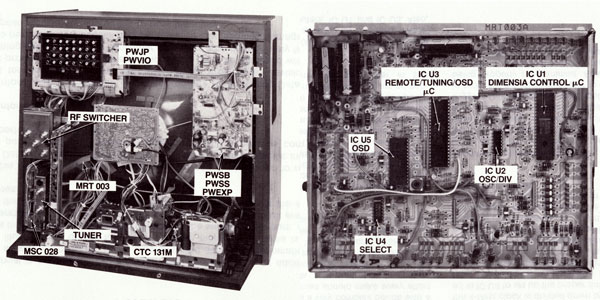
The heart of the Dimensia system is the MRT 003 computer control module, which can be seen mounted inside the TV at the left in the above picture, and opened up on the right. The module contains two microprocessors IC U1 and IC U3, as well as the IC U5 OSD similar in design to the On-Screen Display IC found in 400-series CED players. The Dimensia Control Microcomputer (U1) main tasks are to monitor and process signals on the Dimensia control bus, decode key input from the TV front panel, and transmit/receive to and from the U3 microprocessor. The Remote/Tuning/OSD Microcomputer (U3) decodes the infrared signals sent to the TV from the IR remote control, regulates the MSC 028 Tuner Control Module adjacent to the MRT 003 inside the TV, and generates the on-screen display data for the TV. This microprocessor contains a vocabulary for all front panel display operations except for the system help messages that scroll across the bottom of the screen. These help messages are generated by a third microprocessor inside the RF Switcher module within the TV. Each peripheral component of the Dimensia system contains a microprocessor to interface the component to the shared control bus.
The Dimensia system was introduced in 1984 at a cost of $5000 through select RCA dealers. This price included the TV Monitor, IR Remote, VCR, Amplifier, AM/FM Tuner, Cassette Deck, Turntable, CD Player, and Speakers. The SKT425 CED Player was never part of the marketed system. In 1985, RCA added the MGE160 Graphic Equalizer, the MSA200 Amplifier (a more powerful unit than earlier), the MTT135 Turntable (a front-load style), and the MCD145 CD Player (a replacement for the MCD140). RCA didn't expect big sales for the costly system, but it seems the name itself hindered sales to some degree. The term "Dimensia" was suggested by the wife of a prominent RCA executive, and was intended to evoke "The next dimension in sight and sound" catch phrase for the system. But sales people noticed that customers were dropping quips like "Is this a wacko home entertainment system?" and "Do the components in this system have multiple personalities?" because of the similarity between dimensia and dementia. I've even encountered this confusion in the modern day, as seeking out Dimensia components via search engines brings up many matches that clearly refer to dementia. Google even asks if you meant "Dementia" upon searching for "Dimensia." This could be the reason why the company in 1985 began marketing an "RCA Audio System" which consisted of a receiver, tape deck, turntable, and CD player called Digital Command Components. These were actually Dimensia components with different styling and the Dimensia name removed.
RCA marketed Dimensia in two substantially different series from 1984-1986 and from 1987-1989. The components shown below are from the "classic" 1984-1986 design - the final three years SelectaVision VideoDiscs were still being manufactured. From 1987 to 1989, the distinctive silver-on-black styling of the original system was abandoned in favor of rather nondescript all-black styling. The biggest travesty of the 1987 implementation was the removal of CED player control - the remote will no longer operate a 400-series CED player. This was also the period just after GE swallowed up RCA and was in the process of dismembering it. Although I have a collection of the later-day components, it's the classic 84/85 components that I leave on permanent display with the original monitor.
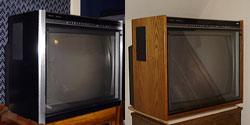 FKC2600 and FKC2601 TV's
FKC2600 and FKC2601 TV's
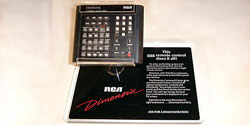 CRK35A Remote Control
CRK35A Remote Control
 SKT425 VideoDisc Player
SKT425 VideoDisc Player
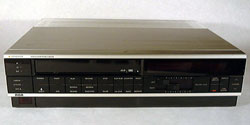 VKT700 VCR
VKT700 VCR
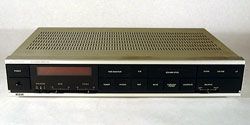 MSA100 Amplifier
MSA100 Amplifier
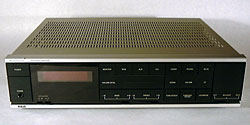 MSA200 Amplifier
MSA200 Amplifier
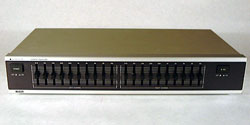 MGE160 Graphic Equalizer
MGE160 Graphic Equalizer
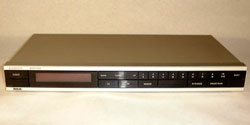 MAT110 AM/FM Tuner
MAT110 AM/FM Tuner
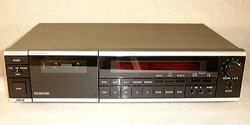 MTR120 Cassette Recorder
MTR120 Cassette Recorder
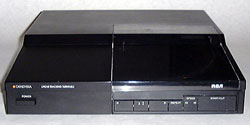 MTT130 LP Turntable
MTT130 LP Turntable
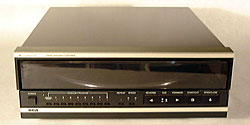 MTT135 LP Turntable
MTT135 LP Turntable
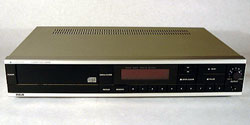 MCD140 CD Player
MCD140 CD Player
 MCD145 CD Player
MCD145 CD Player
 SPK375 Speakers
SPK375 Speakers